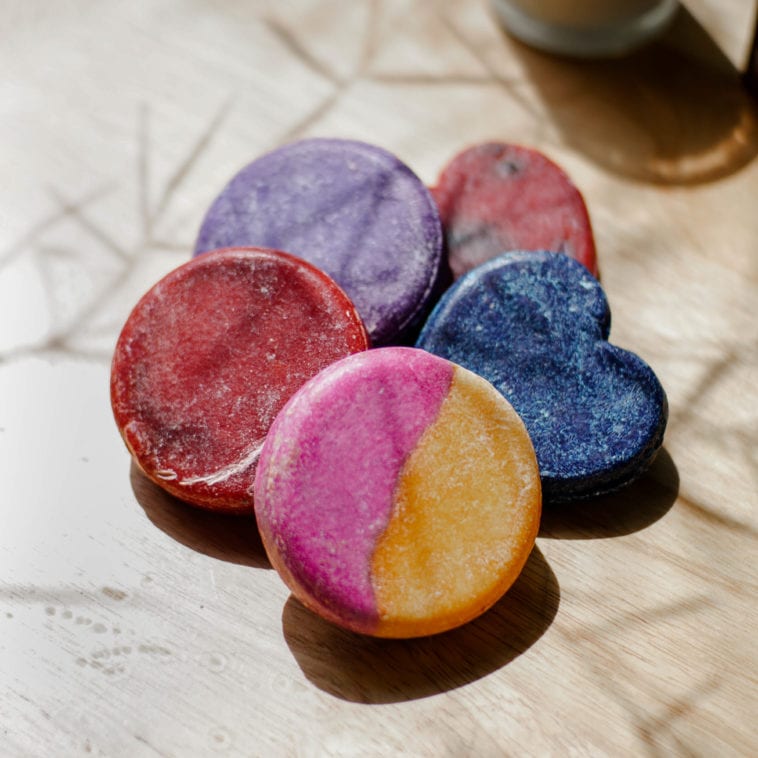When it comes to zero waste swaps, one of the most popular of them is a shampoo bar. Given that most plastic pollution includes sachets and bottles of personal care products such as shampoo, we must switch to a more eco-friendly option. Shampoo bars are lauded for being handy, cost-efficient, and convenient in and out of the bathroom.
Read on to learn more about shampoo bars and why you should use these handy tools to give your hair better care.
What are Shampoo bars?
Shampoo bars are concentrated shampoo made from natural cleansing and conditioning ingredients. They are more long-lasting than liquid shampoo because they don’t contain water. Aside from this, these handmade bars are plant-based – usually made with argan, olive, or coconut oils.
You can order shampoo bars from mostly small businesses that make the bars in small batches with ethical work practices and cruelty-free processes.
Pollution from Liquid Shampoo
It is already second nature to think about shampoo packaged in a sachet or bottle. But not all realize that these packaged liquid shampoos damage our environment, producing pollution in the land, water and air. Most shampoo bottles are made of plastics supplied by the petroleum and fossils industry – which emit a lot of carbon emissions.
Roughly 91% of all plastics are not successfully recycled. And stuck in landfills, strewn carelessly on the ground, and floating in the waters, these plastics cause a lot of damage to the environmental health and wildlife.
According to National Geographic, about nine million tons of plastic enter the oceans annually. This is equivalent to one garbage truck full of plastic being dumped into the sea every minute.
Given the pollution that liquid shampoo packaging can cause, it is already high time for us to break free from plastic. We should switch to shampoo bars from liquid shampoo because they are made to be zero waste with even recycled or reusable packaging such as boxes, cloth pouches, wax wraps, and tin cans.
Dangers of chemical liquid shampoo
Almost all people use liquid shampoos because they feel it works well to give their hair the shine, volume, and softness they want. But it’s very rare for users to read the labels of their shampoo as closely as they do with food labels. Because if they did, they would be horrified at the harsh ingredients their favorite liquid shampoo has such as sodium lauryl sulfate (SLS) that actually damages our hair. SLS and other such controversial ingredients strip one’s hair of its natural oils.
SLS poses fatal health risks such as serious skin and scalp irritations and disease, hair loss, eye damage, depression, breathing difficulties, diarrhea, cancer, and even death.
Shampoo bars vs liquid shampoo
Given that most are accustomed to bathing with liquid shampoo, trying other cleaning tools such as shampoos can be very difficult. But we need to look beyond the convenience and the familiarity with commercial liquid shampoo. You can really find a difference, more than one rather, when you do the switch. Shampoo bars and liquid shampoos differ a lot in terms of their packaging and how they affect our environment, effects to human health, and the product’s lifespan.

| Shampoo Bars | Liquid Shampoo |
| Zero Waste Packaging (paper boxes, tin cans, cloth pouches, or simply shipped naked) which are compostable, reusable, and recyclable | Plastic packaging (sachets and bottles) that are made with harmful ingredients and are not recyclable so they just end up in the oceans or anywhere in the environment |
| Made with plant-based and all-natural ingredients to ensure no adverse effects to the human body | Made with chemicals and other harmful ingredients such as Propylene glycol, Sodium lauryl sulfate, and synthetic fragrances, which can cause headaches, dizziness, and scalp damage. |
| Can offer more benefits to the hair such as reducing frizz, eliminating dandruff, and inducing hair growth | Can give your hair many benefits but also unwittingly damage it with its chemical-laden formulas |
| Travel-friendly – can easily fit into your travel bags or any pouch you have, plus they also don’t leak | Under strict limits during flights, high risk of leakage during transit |
| Lasts longer due to its concentrated form, lasts as long as two to three months | Very easy to use up due to its liquid form |
| cruelty-free, mostly made by small businesses that help out local communities | controversial and can be made with child labor and other unethical practices |
With this, you can decide which shampoo should you use, considering your budget, your health, and the environment. You can still have nice, clean hair without risking your hair health and the environment.
Examining Shampoo Bars
Pros
- zero waste
- made with plant-based and all-natural ingredients
- Cruelty-free production process
- Lasts longer than liquid shampoo
- Travel-friendly
- great for most hair types, including oily, dry, and thin hair
Cons
- Not always best for curly and long hair
- can have a waxy aftereffect on the hair (needing ACV rinse)
How to use a shampoo bar
Haircare expert, Jessica Coles presents two ways you can effectively use shampoo bars:
Use shampoo bar directly on the hair
- Wet your hair.
- Use the bar directly on your hair in a circular motion. make sure you cover and apply it on all parts of your hair from the scalp to the tips.
- Run your fingertips through your hair, especially at the nape of your neck, to massage the shampoo well.
- Rinse your hair thoroughly. Lift hair sections to cleanse them fully of shampoo residue.
Wash with the shampoo bar’s lather.
1. Wet the shampoo bar thoroughly.
2. Rub the shampoo bar between your palms until the bar lathers up thickly.
3. Put the shampoo bar back into its container. Then rub the bubbly lather onto your hair.
4. Massage your hair with the bubbly lather gently. If necessary, repeat steps 1-3 to take care of thicker or longer hair. Make sure that every part of your hair, from the crown to its tips, gets the shampoo bar lather.
5. Rinse your hair thoroughly. Make sure that none of the lather stays in your hair.

If you have long locks, there is a risk of shampoo build-up at the nape of the neck. To avoid this, you can tie your hair into a ponytail or braid. Shampoo as usual, then rinse thoroughly afterward.
Final Step for either shampoo bar technique: Wrap up your hair in a microfiber towel to dab off the extra water. You can air-dry your hair or use a dryer. Once your hair is dried completely, use a wide-toothed comb to remove all knots and tangles.
Transition Period with Shampoo Bars
When our routine has been stuck to certain products, we may feel “weird” when we switch to other products and tools. The same happens when you shift to a zero waste bathroom, including switching to shampoo bars.
Why does this happen?
Body’s Resistance to Change
The human body is resistant to changes in its metabolic status quo. Even if the changes are positive, the bodily response can be virulent. Whatever we change in our daily routines, be it our diet, exercise, or bath routine, we just need to give our bodies time to adjust and adapt to the changes.
Rebalancing Your Hair Health
As people switch to shampoo bars, some will undergo a transition period that can make or break their resolve to go zero waste. They can experience oily or dry scalp, frizzy, waxy hair strands, and other unpleasantness. This happens because the hair has to learn to live without the synthetic chemicals it is used to.
Commercial liquid shampoos are usually made with detergent surfactants that can strip the natural protective oils from your hair. While you may feel your hair running smooth and silky, your scalp is actually dry and extra oily (due to excess sebum (natural oil) production.
Not The Right Shampoo Bar
Ultimately, you can also feel weird or uncomfortable with the shampoo bars you use because it is not the right one for you. Everyone is different, so feel free to try and explore which shampoo bars work for you. What’s great and really zero waste about shampoo bars is their multipurpose design. You can use them as soap if they don’t work for your hair.
How to choose your shampoo bar
There are three basic types of shampoo bars:
- Glycerin-Based: These shampoo bars are good for people who need more gentle shampoo, specifically those with sensitive scalps. This type is pH-balanced with less lather. Store glycerin-based shampoo bars in a cool dry place in your bathroom.
- Cold-Processed: This is the commonly produced shampoo bar at home or by small businesses. Its pH level is usually high, made with lots of natural oils. These are great for conditioning but beware of a waxy build-up. They work best for dry, damaged hair.
- Solid Surfactant: These shampoo bars are very clarifying, removing build-up such as excess oil or chlorine. Their main ingredient –a surfactant, a chemical compound that lowers the surface tension between two substances – enables the bar to become wet easily . They help balance the pH of your hair and produce more lather. This is best for outdoorsy people, who always get their hair dirty.
All in all, it is necessary to learn to listen to your body and to pay attention to your own personal body about which shampoo bar works for you.
Conclusion
Shampoo bars are handy tools for better hair care because they are made to be good for both your hair and the environment. By switching to shampoo bars, you help reduce waste in the bathroom and your household.
You also get to slowly break free from plastic which is not really recycled and just end up in the ocean and landfills. You also reduce the risk of harm from harsh ingredients and unethical practices involved in commercial shampoo brands.
These lightweight, concentrated bars also offer longer wash times – outlasting up to three shampoo bottles. And most importantly, you also support artisan bar makers and other small businesses who produce shampoo bars with marginalized sectors of society.
Showering and cleansing ourselves is one of the common daily tasks we all do. Starting the change in our bathing routines is very significant – especially when you see its effects in the long run. And besides, maintenance of ourselves also requires the proper care and maintenance of our environment. What happens to our surroundings can also impact us significantly – so it is only right to choose to give back what is best to nature by living with less waste.




